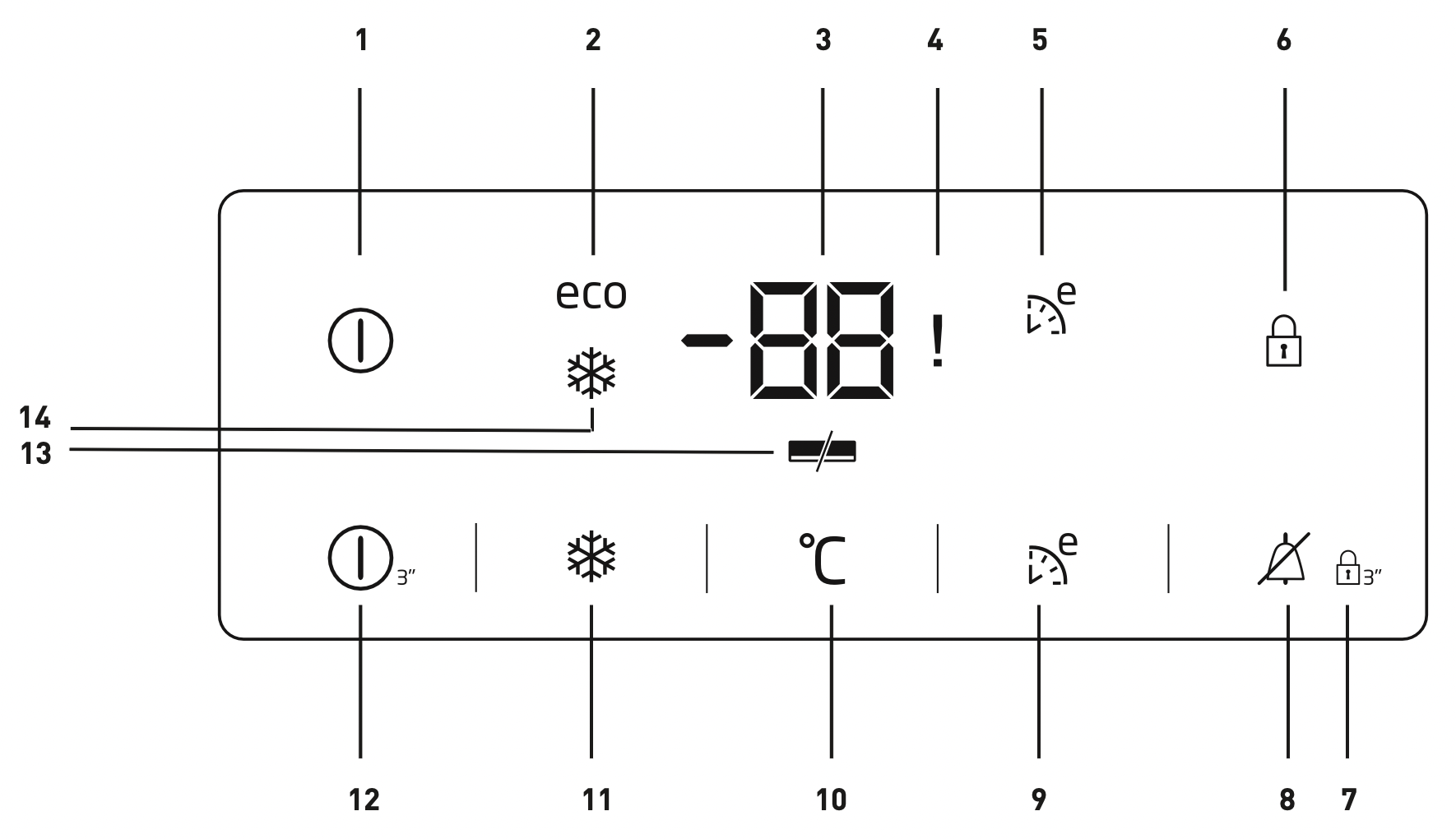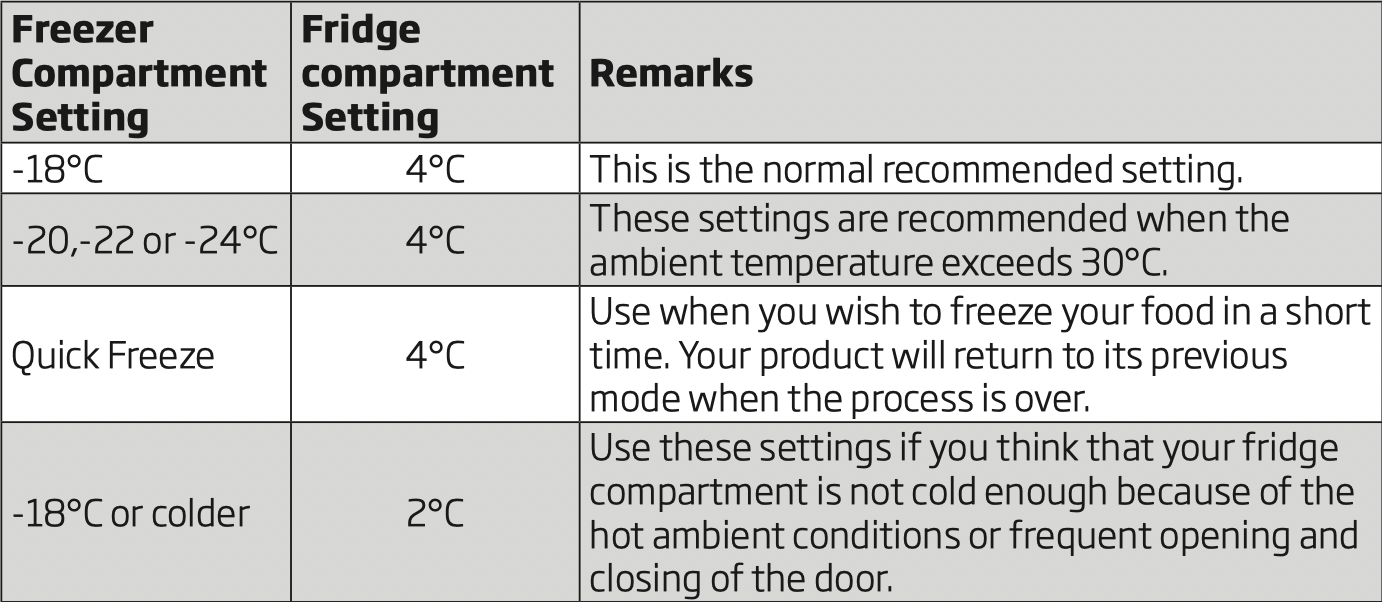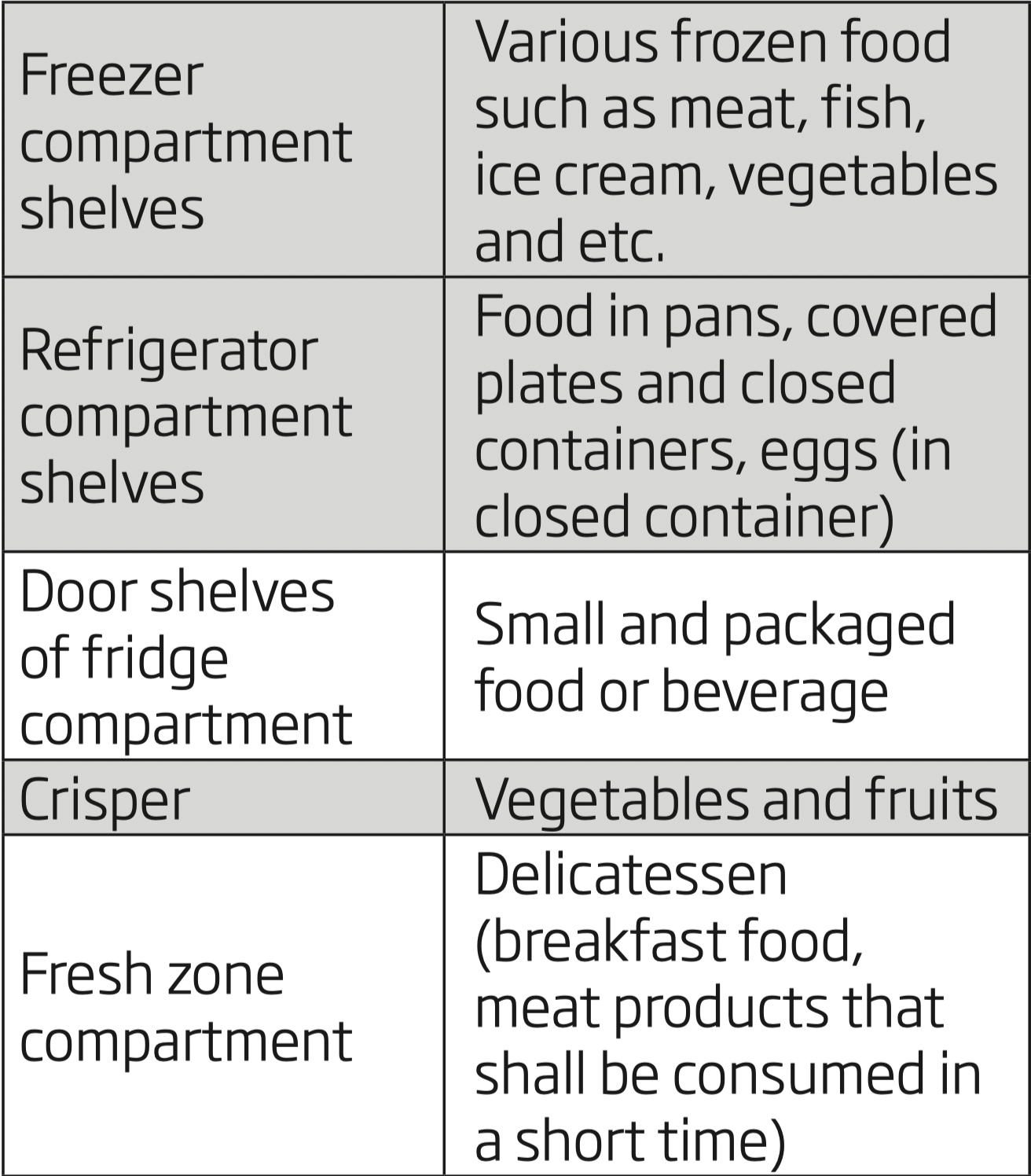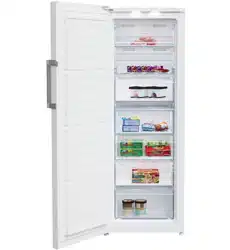Documents: Go to download!
User Manual
- User Manual - (English)
- Specifications Sheet - (English)
- Your Freezer
- Preparation
- Operating the product
- Maintenance and cleaning
- Troubleshooting
Table of contents
Owner's Guide Refrigerator
Your Freezer

- Control Panel
- Flap
- Drawers
- Adjustable front feet
Figures that take place in this instruction manual are schematic and may not correspond exactly with your product. If the subject parts are not included in the product you have purchased, then it is valid for other models.
Preparation
- Your refrigerator should be installed at least 30 cm away from heat sources such as hobs, ovens, central heater and stoves and at least 5 cm away from electrical ovens and should not be located under direct sunlight.
- The ambient temperature of the room where you install your refrigerator should at least be -15°C. Operating your refrigerator under cooler conditions is not recommended with regard to its efficiency.
- Please make sure that the interior of your refrigerator is cleaned thoroughly.
- If two refrigerators are to be installed side by side, there should be at least 2 cm distance between them.
- When you operate your refrigerator for the first time, please observe the following instructions during the initial six hours.
- The door should not be opened frequently.
- It must be operated empty without any food in it.
- Do not unplug your refrigerator. If a power failure occurs out of your control, please see the warnings in the “Recommended solutions for the problems” section.
- Original packaging and foam materials should be kept for future transportations or moving.
- The baskets/drawers that are provided with the chill compartment must always be in use for low energy consumption and for better storage conditions.
- Food contact with the temperature sensor in the freezer compartment may increase energy consumption of the appliance. Thus any contact with the sensor(s) must be avoided.
- In some models, the instrument panel automatically turns off 5 minutes after the door has closed. It will be reactivated when the door has opened or pressed on any key.
- Due to temperature change as a result of opening/closing the product door during operation, condensation on the door/body shelves and the glass containers is normal
Operating the product
Indicator panel

- On/Off Indicator:
This icon ( ) come on when the freezer is turned off. All the other icons turn off.
) come on when the freezer is turned off. All the other icons turn off. - Economic Usage Indicator:
This icon ( ) (comes on when the Freezer Compartment is set to -18°C which is the most economical set value. Economic Usage Indicator turns off when the Quick Fridge or Quick Freeze function is selected.
) (comes on when the Freezer Compartment is set to -18°C which is the most economical set value. Economic Usage Indicator turns off when the Quick Fridge or Quick Freeze function is selected. - Freezer Compartment Temperature Setting Indicator:
Indicates the temperature set for the Freezer Compartment. - Power failure/High temperature / error warning indicator :
This light ( ! ) illuminates during power failure, high temperature failures and error warnings. During sustained power failures, the highest temperature that the freezer compartment reaches will flash on the digital display. - Eco Extra Indicator:
This icon ( ) lights up when this Function is active.
) lights up when this Function is active. - Key Lock Indicator:
See other models: CN151120X FNE1074 BCF307W GNE134620X BFC60VMW1
This icon ( ) lights up when the Key Lock mode is activated.
) lights up when the Key Lock mode is activated. - Key Lock Mode:
Press Key Lock ( ) button continuously for 3 seconds. Key lock icon will light up and key lock mode will be activated. Buttons will not function if the Key Lock mode is active. Press Key Lock button continuously for 3 seconds again. Key lock icon will turn off and the key lock mode will be exite.
) button continuously for 3 seconds. Key lock icon will light up and key lock mode will be activated. Buttons will not function if the Key Lock mode is active. Press Key Lock button continuously for 3 seconds again. Key lock icon will turn off and the key lock mode will be exite. - Alarm off warning:
In case of power failure/high temperature alarm, after checking the food located in the freezer compartment press the alarm off button ( ) to clear the warning.
) to clear the warning. - Eco Extra Function:
Press the Eco Extra button ( ) for 3 seconds to activate Eco Extra Function when going on holday for instance. Freezer will start operating in the most economic mode at around 6 hours later and the economic usage indicator will turn on when the function is active.
) for 3 seconds to activate Eco Extra Function when going on holday for instance. Freezer will start operating in the most economic mode at around 6 hours later and the economic usage indicator will turn on when the function is active. - Freezer Set Function:
This function ( °C ) allows you to change the Freezer compartment temperature setting. Press this button to set the temperature of the freezer compartment to -18, -19, -20, -21, -22, -23 and -24, respectively. - Quick Freeze Function:
Quick Freeze indicator ( ) turns on when the Quick Freeze function is on. Press Quick Freeze button again to cancel this function. Quick Freeze indicator will turn off and normal settings will be resumed.
) turns on when the Quick Freeze function is on. Press Quick Freeze button again to cancel this function. Quick Freeze indicator will turn off and normal settings will be resumed.
Quick Freeze function will be cancelled automatically 3-4 hours later if you do not cancel it manually. If you want to freeze plenty amount food, press Quick Freeze button before you place the food into the freezer compartment. - On/Off Function:
This function ( ) allows you to make the Fridge turn off when pressed for 3 seconds.The fridge could be turned on by pressing On/Off button for 3 seconds again.
) allows you to make the Fridge turn off when pressed for 3 seconds.The fridge could be turned on by pressing On/Off button for 3 seconds again. - Energy Saving Indicator :
If the product doors are kept closed for a long time energy saving function is automatically activated and energy saving symbol is illuminated. ( )
)
When energy saving function is activated, all symbols on the display other than energy saving symbol will turn off. When the Energy Saving function is activated, if any button is pressed or the door is opened, energy saving function will be canceled and the symbols on display will return to normal.
Energy saving function is activated during delivery from factory and cannot be canceled. - Quick Freeze Indicator :
This icon ( ) comes on when the Quick Freeze function is on.
) comes on when the Quick Freeze function is on.
Figures in this user manual are schematic and may not match the product exactly. If the subject parts are not included in the product you have purchased, then those parts are valid for other models.
Freezing fresh food
- In order to preserve the quality of the food, it shall be frozen as quickly as possible when it is placed in the freezer compartment, use the fast freezing feature for this purpose.
- You may store the food longer in freezer compartment when you freeze them while they are fresh.
- Pack the food to be frozen and close the packing so that it would not allow entrance of air.
- Ensure that you pack your food before putting them in the freezer. Use freezer containers, foils and moisture-proof papers, plastic bags and other packing materials instead of traditional packing papers.
- Label each pack of food by adding the date before freezing. You may distinguish the freshness of each food pack in this way when you open your freezer each time. Store the food frozen before in the front side of compartment to ensure that they are used first.
Important: The freezer compartment defrosts automatically. - Frozen food must be used immediately after they are thawed and they should not be re-frozen.
- Do not freeze too large quantities of food at one time.

Recommendations for preserving the frozen food
Compartment shall be set to -18°C at least.
- Put packages in the freezer as quickly as possible after purchase without allowing the to thaw.
- Check whether the "Use By" and "Best Before" dates on the packaging are expired or not before freezing it.
- Ensure that the package of the food is not damaged.
Deep-freeze information
According to IEC 62552 standards, the product shall freeze at least 4.5 kg of food at 32°C ambient temperature to -18°C or lower within 24 hours for every 100-litres of freezer volume.
It is possible to preserve the food for a long time only at -18°C or lower temperatures.
You can keep the freshness of food for many months (at -18°C or lower temperatures in the deep freeze).
Foods to be frozen should not be allowed to come in contact with the previously frozen items to prevent them from getting thawed partially.
Boil the vegetables and drain their water in order to store vegetables for a longer time as frozen. After draining their water, put them in air-proof packages and place them inside the freezer. Food such as bananas, tomatoes, lettuce, celery, boiled eggs, potatoes are not suitable for freezing. When these foods are frozen, only their nutritional value and taste shall be affected negatively. They shall not be spoiled so that they would create a risk for human health.
Placing the food

Door open warning (This feature is optional)
An audio warning signal will be given when the door of your product is left open for at least 1 minute. This warning will be muted when the door is closed or any of the display buttons (if any) are pressed.
Door open warning is given to user both visually and acoustically. If the warning continues for 10 minutes, interior lights will be turned off.
Changing the door opening direction
Door opening direction of your refrigerator can be changed according to the place you are using it.If this is necessary, please call your nearest Authorized Service.
Above description is a general expression.For information on changing the opening direction of the door, you must refer to the warning label located on the inner side of the door.
Ice Pack
Ice subsitute pack decelerates thawing of stored frozen food in case of blackout or malfunction. Placing the pack directly on top of the food will enable the longest storing period.
Ice substitute pack can also be used to keep food temporarily cold, e.g. in a cooler bag.
Changing the illumination lamp
To change the Bulb/LED used for illumination of your refrigerator, call your AuthorisedService.
The lamp(s) used in this appliance is not suitable for household room illumination. The intended purpose of this lamp is to assist the user to place foodstuffs in the refrigerator/freezer in a safe and comfortable way.
The lamps used in this appliance have to withstand extreme physical conditions such as temperatures below -20 °C. (only chest and upright freezer)
Maintenance and cleaning
Cleaning your fridge at regular intervals will extend the service life of the product.
WARNING: Unplug the product before cleaning it.
- Never use gasoline, benzene or similar substances for cleaning purposes.
- Never use any sharp and abrasive tools, soap, household cleaners, detergent and wax polish for cleaning.
- Dissolve one teaspoon of bicarbonate in half litre of water. Soak a cloth with the solution and wrung it thoroughly. Wipe the interior of the refrigerator with this cloth and the dry thoroughly.
- Make sure that no water enters the lamp housing and other electrical items.
- If you will not use the refrigerator for a long period of time, unplug it, remove all food inside, clean it and leave the door ajar.
- Check regularly that the door gaskets are clean. If not, clean them.
- To remove door and body shelves, remove all of its contents.
- Remove the door shelves by pulling them up. After cleaning, slide them from top to bottom to install.
- Never use cleaning agents or water that contain chlorine to clean the outer surfaces and chromium coated parts of the product. Chlorine causes corrosion on such metal surfaces.
Avoiding bad odours
Materials that may cause odour are not used in the production of our refrigerators. However, due to inappropriate food preserving conditions and not cleaning the inner surface of the refrigerator as required can bring forth the problem of odour. Pay attention to following to avoid this problem:
- Keeping the refrigerator clean is important. Food residuals, stains, etc. can cause odour. Therefore, clean the refrigerator with bi-carbonate dissolved in water every few months. Never use detergents or soap.
- Keep the food in closed containers. Microorganisms spreading out from uncovered containers can cause unpleasant odours.
- Never keep the food that have passed best before dates and spoiled in the refrigerator.
Protecting the plastic surfaces
Do not put liquid oils or oil-cooked meals in your refrigerator in unsealed containers as they damage the plastic surfaces of the refrigerator. If oil is spilled or smeared onto the plastic surfaces, clean and rinse the relevant part of the surface at once with warm water.
Troubleshooting
Check this list before contacting the service. Doing so will save you time and money. This list includes frequent complaints that are not related to faulty workmanship or materials. Certain features mentioned herein may not apply to your product.
The refrigerator is not working.
- The power plug is not fully settled. > > > Plug it in to settle completely into the socket.
- The fuse connected to the socket powering the product or the main fuse is blown. > > > Check the fuses.
Condensation on the side wall of the cooler compartment (MULTI ZONE, COOL, CONTROL and FLEXI ZONE).
- The door is opened too frequently > > > Take care not to open the product’s door too frequently.
- The environment is too humid. > > > Do not install the product in humid environments.
- Foods containing liquids are kept in unsealed holders. > > > Keep the foods containing liquids in sealed holders.
- The product’s door is left open. > > > Do not keep the product’s door open for long periods.
- The thermostat is set to too low temperature. > > > Set the thermostat to appropriate temperature.
Compressor is not working.
- In case of sudden power failure or pulling the power plug off and putting back on, the gas pressure in the product’s cooling system is not balanced, which triggers the compressor thermic safeguard. The product will restart after approximately 6 minutes. If the product does not restart after this period, contact the service.
- Defrosting is active. > > > This is normal for a fully-automatic defrosting product. The defrosting is carried out periodically.
- The product is not plugged in. > > > Make sure the power cord is plugged in.
- The temperature setting is incorrect. > > > Select the appropriate temperature setting.
- The power is out. > > > The product will continue to operate normally once the power is restored.
The refrigerator's operating noise is increasing while in use.
- The product’s operating performance may vary depending on the ambient temperature variations. This is normal and not a malfunction.
The refrigerator runs too often or for too long.
- The new product may be larger than the previous one. Larger products will run for longer periods.
- The room temperature may be high. > > > The product will normally run for long periods in higher room temperature.
- The product may have been recently plugged in or a new food item is placed inside. > > > The product will take longer to reach the set temperature when recently plugged in or a new food item is placed inside. This is normal
- Large quantities of hot food may have been recently placed into the product. > > > Do not place hot food into the product.
- The doors were opened frequently or kept open for long periods. >>> The warm air moving inside will cause the product to run longer. Do not open the doors too frequently.
- The freezer or cooler door may be ajar. > > > Check that the doors are fully closed.
- The product may be set to temperature too low. > > > Set the temperature to a higher degree and wait for the product to reach the adjusted temperature.
- The cooler or freezer door washer may be dirty, worn out, broken or not properly settled. > > > Clean or replace the washer. Damaged / torn door washer will cause the product to run for longer periods to preserve the current temperature.
The freezer temperature is very low, but the cooler temperature is adequate.
- The freezer compartment temperature is set to a very low degree. >>> Set the freezer compartment temperature to a higher degree and check again.
The cooler temperature is very low, but the freezer temperature is adequate.
- The cooler compartment temperature is set to a very low degree. > > > Set the freezer compartment temperature to a higher degree and check again.
The food items kept in cooler compartment drawers are frozen.
- The cooler compartment temperature is set to a very low degree. > > > Set the freezer compartment temperature to a higher degree and check again.
The temperature in the cooler or the freezer is too high.
- The cooler compartment temperature is set to a very high degree. > > > Cooler compartment temperature setting has an effect on the freezer compartment temperature. Change the temperature of the cooler or freezer compartment and wait until the temperature of the related compartments come to the adequate level.
- The doors were opened frequently or kept open for long periods. > > > Do not open the doors too frequently.
- The door may be ajar. > > > Fully close the door.
- The product may have been recently plugged in or a new food item is placed inside. > > > This is normal. The product will take longer to reach the set temperature when recently plugged in or a new food item is placed inside.
- Large quantities of hot food may have been recently placed into the product. > > > Do not place hot food into the product.
Shaking or noise.
- The ground is not level or durable. > > > If the product is shaking when moved slowly, adjust the stands to balance the product. Also make sure the ground is sufficiently durable to bear the product.
- Any items placed on the product may cause noise. > > > Remove any items placed on the product.
The product is making noise of liquid flowing, spraying etc.
- The product’s operating principles involve liquid and gas flows. > > > This is normal and not a malfunction.
There is sound of wind blowing coming from the product.
- The product uses a fan for the cooling process. This is normal and not a malfunction.
There is condensation on the product's internal walls.
- Hot or humid weather will increase icing and condensation. This is normal and not a malfunction.
- The doors were opened frequently or kept open for long periods. > > > Do not open the doors too frequently; if open, close the door.
- The door may be ajar. > > > Fully close the door.
There is condensation on the product's exterior or between the doors.
- The ambient weather may be humid, this is quite normal in humid weather. > > > The condensation will dissipate when the humidity is reduced.
The interior smells bad.
- The product is not cleaned regularly. > > > Clean the interior regularly using sponge, warm water and carbonated water.
- Certain holders and packaging materials may cause odour. > > > Use holders and packaging materials without free of odour.
- The foods were placed in unsealed holders. > > > Keep the foods in sealed holders. Microorganisms may spread out of unsealed food items and cause malodour.
- Remove any expired or spoilt foods from the product.
The door is not closing.
- Food packages may be blocking the door. > > > Relocate any items blocking the doors.
- The product is not standing in full upright position on the ground. > > > Adjust the stands to balance the product.
- The ground is not level or durable. > > > Make sure the ground is level and sufficiently durable to bear the product.
The vegetable bin is jammed.
- The food items may be in contact with the upper section of the drawer. > > > Reorganize the food items in the drawer.
WARNING: If the problem persists after following the instructions in this section, contact your vendor or an Authorized Service. Do not try to repair the product.
